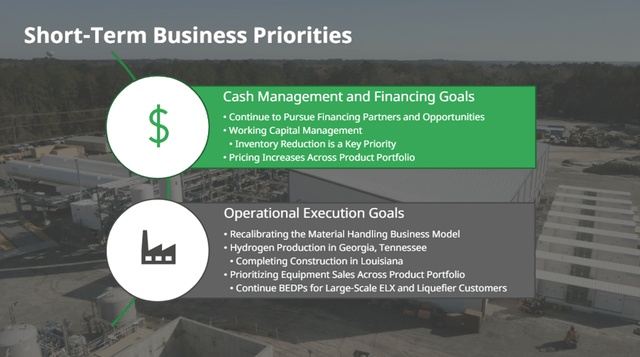Summary:
- Plug Power has had a terrible Q1 2024 seeing declines in both revenues and Net Income.
- The company has started production of its “green hydrogen” which will hopefully begin to mitigate these losses.
- The continued losses and its size have made me skeptical that management’s turnaround plan will be sufficient.
DNY59
Plug Power (NASDAQ:PLUG) has recently reported terrible Q1 2024 results. Yet management is optimistic about a turnaround. In this article, I examine the bull case for a turn-around and look at the mounting losses the company faces for its bear case.
Plug Power Begins Hydrogen Production
One of the main issues facing Plug Power is that it is losing money on a Gross Margin basis. In order to entice major customers to adopt hydrogen forklifts and other equipment, the company has had to agree to fixed-price contracts for their hydrogen supply. This becomes a problem when the price of hydrogen increases and Plug Power has to sell hydrogen at a loss. This has resulted in the company being a cash burner for the past few years.
Given the poor economics of Plug Power’s current business set-up, the company needs to be able to obtain hydrogen at a much cheaper rate or sell it at a higher price. A two-pronged strategy is being pursued by management. In theory, Plug Power’s business is just a “razor and blades model” except in this situation the company is losing money on the “blades” as well.
As part of the overall solution, the company has started producing its own “green hydrogen” with the hope that the production costs will be cheaper than procuring in the open market. The company has moved one step closer to this goal as it has reached the maximum output under ideal conditions for both its Georgia and Tennessee hydrogen plants. The two plants together have reached 25 tons per day (TPD) of liquid hydrogen production. This equates to roughly 50% of Plug Power’s green hydrogen demand. In Q3 2024 the company plans to open its Louisiana plant adding another 15 tons per day of capacity.
As stated by CEO Andy Marsh; “As part of our initiative to strengthen financial performance, we are pleased to make headway in a two-prong strategy: lower cost sourced hydrogen through capacity expansions at our Georgia and Tennessee plants coupled with improved margins through the recalibration of pricing across our portfolio”
Plug Power’s Terrible Q1 2024 Results
Plug Power has had a terrible Q1 2024. The company reported revenues of $120.3 million a 43% decline from the $210.3 million reported the same time last year. This has resulted in a wider loss in Q1 2024 of $295.8 million or $0.46 EPS compared to $206.6 million or $0.35/share. It should be noted that the company’s losses this quarter are more than double its revenue.
The losses are still substantial even if we reverse the one-time expenses due to restructuring and non-cash asset write-downs. These expenses are $6 million and $40 million respectively. Assuming that these are non-recurring gives us a total Net loss of $249.8 million. Annualizing this loss gives me a rough loss of $999.2 million for the full year 2024.
The company recently announced job cuts and supply chain optimizations to reduce annual expenses by $75 million. It also plans to curb discretionary spending and push for more automation and digital technology in its facilities. However, even optimistically these cuts will not make a major dent in the company’s operating losses. Furthermore, these cuts could hurt revenue at a time when the company needs it most.
Looking over margins, for the quarter management has noted that it “saw headwinds on equipment margins given focus on lowering inventory and limiting production, coupled with lower sales level collectively generating unfavorable overhead absorption”. Coupled with the decline in revenue, this potentially signals to me difficulty in selling the company’s green products. The difficult environment has forced many corporations to start reducing costs and cutting budgets. It wouldn’t surprise me that environmentally focused projects would be among the first to go in a round of cost cuts.
Analyzing Plug Power’s Liquidity
As mentioned above, Plug Power’s management is hoping the combination of its restructuring and the start of hydrogen production should be enough to turn around the company’s fortunes. Note that the company had announced in its 2023 annual report that it was no longer a “No going-concern” risk. For this to continue to be the case Plug Power would need to carefully manage its existing cash levels.
For Q1 2024, Plug Power’s management has stated that the Net cash used in operating activities and capital expenditures fell by 42% year over year. Digging further into the company’s cashflows most of the cash savings come from a reduction in cash used for operating activities which is a good thing as it could indicate cost savings. Net cash used in operating activities fell from $ 276.9 million to $167.7 million. Cash used to Purchase Plug Power’s property, plant and equipment fell from $ 168.5 million to $ 92.6 million. Again, cutting cash expenditures can be a double-edged sword as money in capital and operations is usually needed to grow or maintain revenue. What I would like to see from Plug Power in the next few quarters is whether or not revenue at least stabilizes at the current level.

Q1 2024 Presentation
Looking into the Balance Sheet to gauge the company’s liquidity situation, As of the latest quarter, the company had cash of $172.9 million and restricted cash of $1.0 billion. The company’s restricted cash is due to a sale/leaseback transaction so it should be subject to a few covenants and not available for general purpose use. For the simplicity of this analysis though let’s consider it as well, so that makes it $1.17 billion restricted and unrestricted cash in total.
Plug Power also signed an agreement with B. Riley Securities for an “At Market Issuance Sales Agreement”. This allows the latter to offer and sell common stock worth up to $1 billion. While this is potentially dilutive to existing shareholders, it will allow the company to survive if it needs the liquidity.
The final source of funds for Plug Power is from the US government. The Department of Energy has awarded grants totaling $75.7 million to Plug Power and is also considering extending a $1.6 billion low-interest loan. These funds are part of the Biden administration’s $1 trillion infrastructure bill to boost US green energy production. Plug Power’s management seems optimistic that it will be granted this loan.
Conclusion
There are a number of “red flags” for Plug Power that lead me to conclude that this stock is a “Strong Sell”. The focus on just trying to maintain adequate liquidity signals to me that the company is mainly trying to “survive” and not “thrive”.
As current results continue to be disappointing, most of Plug Power’s $1.7 billion market cap is attributable to investor belief in its hydrogen production turn-around. However, there is room to be pessimistic though as declining revenues this quarter have resulted in ballooning Net losses despite management’s best efforts at cost-cutting. If the bad news continues to mount, I believe investor confidence could erode, leading to a continued decline in the stock.
Analyst’s Disclosure: I/we have no stock, option or similar derivative position in any of the companies mentioned, and no plans to initiate any such positions within the next 72 hours. I wrote this article myself, and it expresses my own opinions. I am not receiving compensation for it (other than from Seeking Alpha). I have no business relationship with any company whose stock is mentioned in this article.
Seeking Alpha’s Disclosure: Past performance is no guarantee of future results. No recommendation or advice is being given as to whether any investment is suitable for a particular investor. Any views or opinions expressed above may not reflect those of Seeking Alpha as a whole. Seeking Alpha is not a licensed securities dealer, broker or US investment adviser or investment bank. Our analysts are third party authors that include both professional investors and individual investors who may not be licensed or certified by any institute or regulatory body.
